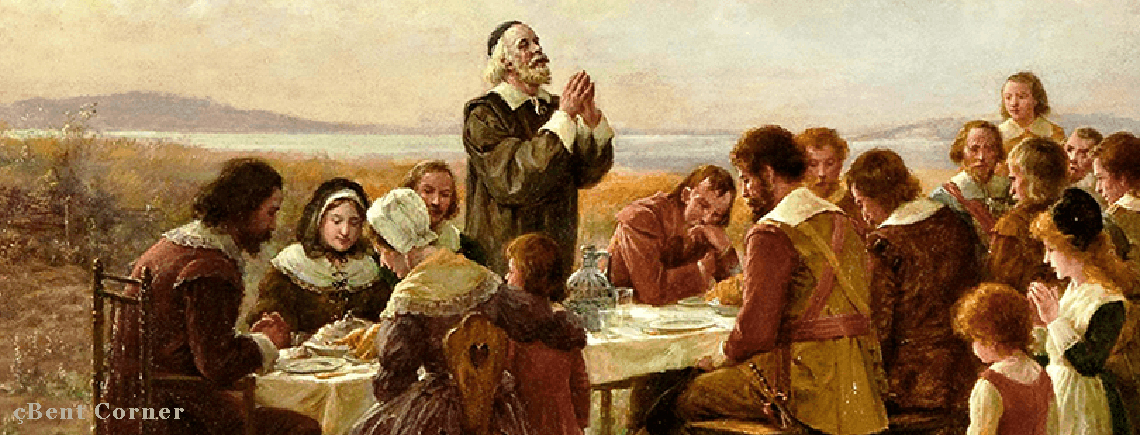The Myth of the Groaning Board
At the end of this month we will sit down for a feast of Thanksgiving but we may have to dig deep after this enormously fraught year to define what we are thankful for.
Yes, 2020 has been a tough year and it promises to remain so until the end. But, upon reflection, we can all summon something to be grateful for. And, after having endured the tremendous disruption of COVID-19, a political maelstrom, racial divisions and massive hurricanes and fires, managing to find a thankful heart will place us squarely in the tradition of our Pilgrim forebears.
They, too, had a perfectly dreadful year before that first Thanksgiving in 1621. In mid-November 1620, poor planning and bad navigation brought them to a cold, stony New England coastline rather than to the milder climate of their intended Virginia destination. They could not begin construction of their town until January 9th and on January 14th awoke to find the roof of their Common House, their first structure, on fire.
Soon, the repaired building was crowded with sick and dying Pilgrims as either typhus or infectious pneumonia marched through their ranks killing 45 of the 101 Mayflower passengers. Every man, woman and child suffered that winter from piercing cold, a lack of adequate shelter and dwindling food supplies. And yet they found reason for hope.
If modern Americans are looking for a reason to be grateful this year, they might find it in not being required to eat the meal placed before the men during that Thanksgiving so long ago. I say “placed before the men” because the women would have found scant time to eat. Only four married women survived the winter and feeding 90 visiting Indians and the remaining 56 Pilgrims surely tied them perpetually to their cooking fires.
The romanticized image of white-capped women carrying platters of food to tables surrounded by Pilgrim fathers and visiting Indians is also not true. The feast took place over three days sometime between September and November and people would have eaten whenever the spirit moved them. There was a paucity of furniture and any flat surface was used to lay out the food. Everyone sat where they could.
No record exists of the exact bill of fare but you would not have eaten a self-basting turkey bred to produce a maximum amount of juicy breast meat but rather tough and stringy wild fowl. Neither would you have consumed buttered rolls (there was no butter or ovens for baking); bread stuffing (acorns and wild herbs would have sufficed); heaped your plate with potatoes (unknown in New England at the time), or finished the meal with pumpkin pie. If you had cranberries at all, they would been a mouth-puckering garnish (no sugar remained in their larders) rather than a tart sauce.
The first Thanksgiving, nevertheless, grew out of a sense of satisfaction with the colonists’ successes. Governor William Bradford remembered, “They begane now to gather in ye small harvest they had, and to fitte up their houses and dwellings against winter, being all well recovered in health & strength, and had all things in good plenty; for as some were thus imployed in affairs abroad, others were excersised in fishing, aboute codd, & bass, & other fish, of which yey tooke good store, of which every family had their portion. All ye somer ther was no want.”
The Pilgrim chronicler Edward Winslow noted, “Our harvest being gotten in, our governor sent four men fowling, that so we might after a special manner rejoice together, after we had gathered the fruits of our labors; they four in one day killed as much fowl, as with a little help beside, served the Company almost a week.” The fowl may—or may not—have included wild turkeys, but almost certainly would have included ducks, geese, swans and the like.
The “little help” would have come from visiting Native Americans, who provided five deer. Add to that, food drawn from the sea, the limited variety of vegetables grown by the colonists and native plants, all boiled lovingly to mush over open fires, and you had your first Thanksgiving dinner.
Some of the groaning board’s contents would be delicacies today but were despised by the Pilgrims. The abundant seafood served was considered the provender of the poor. In 1622 Governor William Bradford of the Plymouth Plantation apologized to a new arrival that the only dish he "could presente their friends with was a lobster...without bread or anything else but a cupp of fair water.”
Clam and oysters were also considered a sign of deprivation and poverty because of the backbreaking work of collecting them in sufficient amounts to feed large Colonial households. In the book, America’s Founding Food, the collection of such foods is termed “sweaty, muddy, back-breaking, often plagued by horseflies.” Gender politics also came into the perception of seafood—collection of mollusks being considered to be women’s work and making them a “low priority foodstuff.”
Today, a Thanksgiving dinner is still a major effort for the chef but with modern kitchens, the ease of shopping for ingredients, the wide variety of foodstuffs available and a comfortable chair to fall into when all the work is done we can readily find something to be grateful for—perhaps not least that someone eventually invented pumpkin pie!

